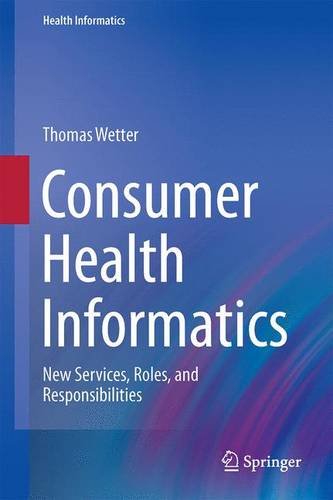 Editor: Thomas Wetter
Editor: Thomas Wetter
Contributors: George Demiris, Amanda K. Hall, Andrea Hartzler, Jina Huh, Georgios Raptis, and Lisa M. Vizer
Publisher: Springer – 417 pages
Book Review by: Sonu Chandiram
We are reaching the age of the consumer empowerment in health care, especially in the more highly-educated sectors of the developed world, such as in Europe and the United States. Recall the numerous times when you have:
- Searched the Internet on a medical issue
- Networked with others to get answers to critical health questions
- Tracked your physical activity with wearable devices
- Measured your physiological reactions in strength tests, resistance to cold weather, etc.
- Monitored your diet to control diabetes or lose weight
- Communicated with a doctor without having to visit him or her
It is information that empowers us and the more accurate and correct it is, the more helpful it is to us. We are essentially consumers of health information, which empowers us to make the right decisions about us and the health of our family members.
This is a far cry from decades ago when for any small medical problem, we went to visit our doctor, perhaps wait a long time, be diagnosed for our ailment and be given some medicine.
This book, Consumer Health Informatics, aims to help you in the use of modern computers and telecommunications to obtain information, analyze your unique health care needs, and help make the right decisions. Below is an overview of the topics this book covers to help you understand its breadth and depth:
- Introducing the Domain and Levels of Service
- Character of Domain and Organization of Book
- Economy 1: Imminent Mismatch Between Demand and Supply of Health Care Workforce
- Level 0: Searching – Finding – Training – Acting – Risking One’s Life?
- Level 1: Enhancing the Provider – Client Relation Through IT
- Level 2: Services Without In-Person Contact Between Provider and Client
- Level 3: Patient Power on the Web: The Multifaceted Role of Personal Health Wisdom
- Distinctive Features of Services Conveyed Through Mobile Apps
- Building Safety Nets Around the Active Client
- Dimensions of Patient Risks and Requirements for Patient Safety
- Services for All Stages of the Metabolic Syndrome and Its Consequences
- Basic Services Reach Out Towards Under-Served Populations
- Smart Homes: Empowering the Patient Till the End
- Partial Solutions for Patient Safety
- Additional Methodology
- Privacy and Data Protection: Mission Impossible?
- The Patient-Centered Electronic Health Record and Patient Portals
- Scrutinized Proof of Effectiveness or Cost Effectiveness Regarding Patient Reported Outcomes
- Economy 2: Economic Subsistence of Services When Research Funding Ends
- Towards Future Consumer Health Informatics Adapted Health Care Legislation
Editor:
Thomas Wetter is associated with the Institute for Medical Biometry and Informatics at the University of Heidelberg in Heidelberg, Germany.
Contributors:
George Demiris
Amanda K. Hall
Andrea Hartzler
Jina Huh
Georgios Raptis
Lisa M. Vizer







